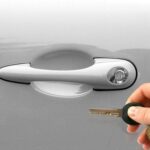Hands-free car entry systems offer unparalleled convenience, automatically unlocking your car doors as you approach, without you needing to press any buttons. However, this convenience comes with a security risk. Criminals are now exploiting vulnerabilities in these keyless systems using readily available devices. Reports are surfacing of thieves utilizing “mystery devices” to gain unauthorized access to vehicles equipped with hands-free entry. Once inside, they can steal valuables and, more alarmingly, potentially access the car’s diagnostic port to download information needed to create a duplicate key, enabling vehicle theft. Police are actively warning about this growing issue of keyless vehicle theft.
Concerned about protecting your car and its contents? Understanding the range of your key fob and how these attacks work is the first step towards safeguarding your vehicle.
While various methods of hacking keyless entry systems have been discussed, including sophisticated techniques presented at security conferences, the currently prevalent threat revolves around signal boosting.
The intended operation of your key fob is for communication with your car to occur only when the fob is in close proximity – typically within a yard or so of the vehicle. This short-range communication is designed to ensure that your car unlocks only when you, the owner, are nearby. However, a simple yet effective device, a wireless signal booster, can amplify the communication range between your fob and car. This amplification tricks your car into thinking the key fob is nearby, even when it’s significantly further away. Alarmingly, some reports indicate that signal boosters available online can extend the key fob range to the distance of an entire football field! This drastically increases the vulnerability of your vehicle.
Imagine parking your car near your house, perhaps in your driveway. A thief using a signal booster can easily exploit this. The device allows your car to “see” the key fob inside your home as if it were right next to the vehicle. This process is almost instantaneous, allowing the thief to unlock your car door as easily as if you were standing beside it. The same risk applies in various scenarios: office parking lots while you are at work, restaurant parking lots during dinner, or even public parking spaces. While walls and other obstacles might sometimes interfere with a thief’s signal boosting attempt, numerous successful break-ins prove that these are not reliable defenses.
Car manufacturers could implement straightforward solutions to mitigate this vulnerability. One option is requiring a button press on the key fob to activate it, although this might be perceived as less convenient. Another, more robust solution involves incorporating technology into vehicles that can accurately determine the distance of the key fob, rather than solely relying on easily amplified short-range signals.
In the interim, if your car system offers an option to disable the proximity feature and rely on button presses for unlocking, utilizing this feature is a wise precaution. If such a setting isn’t available, the simplest and most effective immediate solution to prevent unauthorized access is to wrap your car fob in aluminum foil. Aluminum foil effectively blocks the communication signals, preventing signal boosting. Simply unwrap it slightly when you need to use your fob. For spare fobs stored at home, keep them wrapped in foil as well. For a more refined and durable option than foil, consider using a “Faraday Bag,” readily available from online retailers like Amazon and other stores. Faraday bags are specifically designed to block electromagnetic fields, providing a secure enclosure for your key fob.
Unfortunately, some misguided and potentially harmful suggestions for preventing key fob signal boosting have been circulating in the media. It’s crucial to be aware of these and avoid them. One example, published in The New York Times, suggested storing key fobs in home freezers. This is ineffective for protecting your car when you are away from home, such as at work or shopping. Furthermore, freezer temperatures can damage your key fob, either directly or through condensation issues. Even worse is the suggestion to store key fobs in microwave ovens. Beyond the ineffectiveness when away from home, placing anything non-microwave-safe in a microwave is extremely dangerous. Someone might unknowingly attempt to use the microwave with the fob inside, potentially destroying the fob and creating a fire hazard.
Recommendations from law enforcement agencies like Scotland Yard, such as parking in well-lit areas under video surveillance and using a steering wheel lock, are prudent general security measures. These actions may deter opportunistic thieves and reduce your car’s attractiveness as a target. However, they do not address the fundamental vulnerability of key fob signal boosting. While helpful, these strategies may also be impractical for many car owners in various situations.
Maintaining your car keys on your nightstand for quick access to the panic button in emergencies remains a valid safety tip. However, if you are concerned about key fob signal boosting, especially if your car is parked outside of a garage, simply storing your keys in an easily accessible piece of aluminum foil offers a practical and immediate layer of protection.
